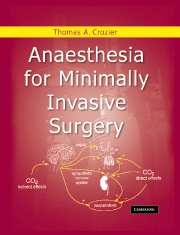Book contents
- Frontmatter
- Contents
- Preface
- Foreword
- Acknowledgements
- 1 Introduction
- 2 Physiology
- 3 Preparing and positioning for laparoscopic surgery
- 4 Monitoring
- 5 Anaesthesia for laparoscopic surgery
- 6 Complications and contraindications of laparoscopic surgery
- 7 Post-laparoscopy pain and pain relief
- 8 Laparoscopic bariatric surgery
- 9 Minimally invasive thoracic surgery
- 10 Laser surgery of the upper aerodigestive tract
- 11 Minimally invasive neurosurgery
- Index
7 - Post-laparoscopy pain and pain relief
Published online by Cambridge University Press: 21 October 2009
- Frontmatter
- Contents
- Preface
- Foreword
- Acknowledgements
- 1 Introduction
- 2 Physiology
- 3 Preparing and positioning for laparoscopic surgery
- 4 Monitoring
- 5 Anaesthesia for laparoscopic surgery
- 6 Complications and contraindications of laparoscopic surgery
- 7 Post-laparoscopy pain and pain relief
- 8 Laparoscopic bariatric surgery
- 9 Minimally invasive thoracic surgery
- 10 Laser surgery of the upper aerodigestive tract
- 11 Minimally invasive neurosurgery
- Index
Summary
Patterns and mechanism of post-laparoscopy pain
The majority of laparoscopic operations are performed as short-stay or even day-care surgery. Although pain is less severe and of shorter duration than following open procedures (Table 7.1), it can still be sufficiently intense to prevent early discharge. The pain after laparoscopic surgery has a spatial distribution and character that is so unique that it is often referred to as the “post-laparoscopic pain syndrome”. Pain arises from the trocar insertion sites, the intra-abdominal trauma and also from the rapid distension of the peritoneum with traumatic traction on blood vessels and nerves, irritation of the phrenic nerve and release of inflammatory mediators (see reviews in Refs [3,4]). The pain presents as parietal pain in the insertion sites, visceral pain from the intra-abdominal wound and the irritated peritoneum, and pain referred to the shoulder tip, a characteristic feature, or to the back. Post-laparoscopic pain is most frequently located in the upper abdomen, independent of the intra-abdominal localization of the operation site.
Pain tops the list of complaints following laparoscopic surgery, with up to 96% of the patients complaining of postoperative pain (Table 7.1). It is most intense immediately after the operation, but decreases rapidly. In one study, the patients quantified the initial intensity as 60 on a 100 point visual analogue scale (VAS), but it had decreased under therapy to approximately 30 VAS points within 2h. This is equivalent to a verbal pain score of 2–2.5 on a six-point scale (see Table 7.2). Women consistently reported more intense pain than men.
- Type
- Chapter
- Information
- Anaesthesia for Minimally Invasive Surgery , pp. 93 - 98Publisher: Cambridge University PressPrint publication year: 2004
- 1
- Cited by



